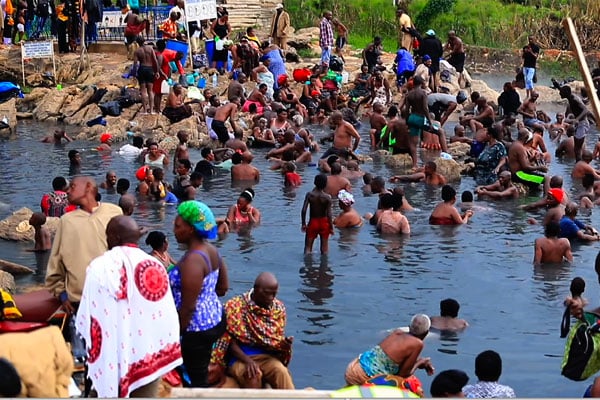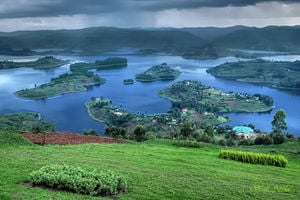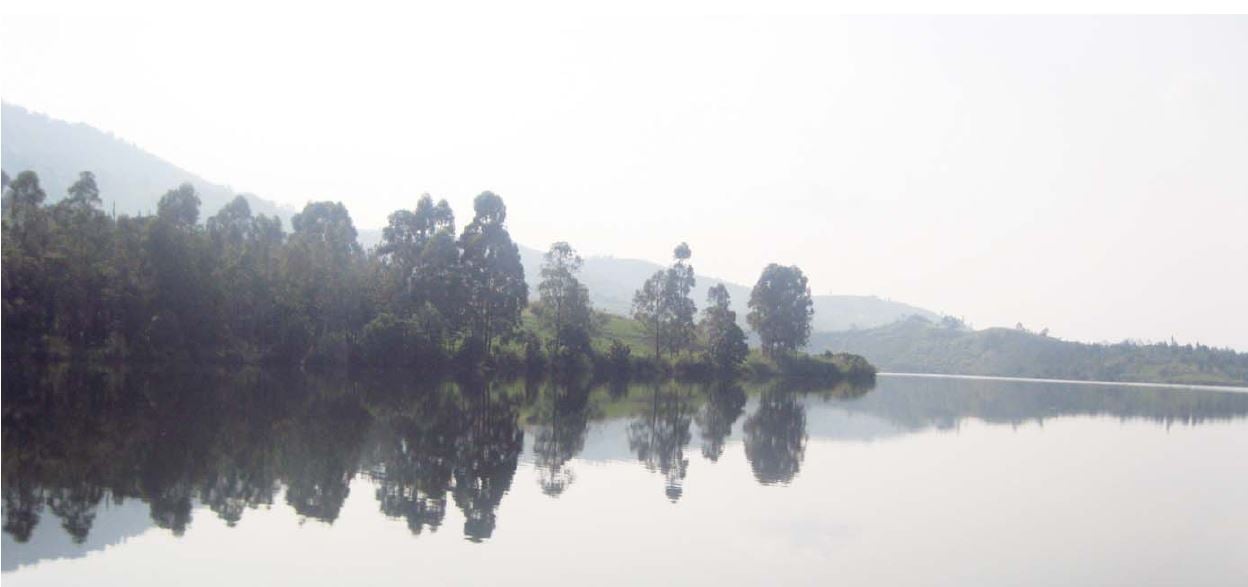
People soaking in the Kitagata hot springs. PHOTOS/ HERBERT KAMOGA
The chatter of people seeking healing in the Kitagata hot springs carries a distance even before one moves closer. The space near the springs is filled with motorcycles and vehicles. There are tens of people bathing in the steam-emitting warm water. Many have come from far-flung places.
Roy Rukundo comes from Kampala but her backache drove her to the hot springs.
“I was told the water has healing properties depending on the diseases you carry. Bathing in the hot water can heal backaches, malaria, and wounds. This is the fifth time I have come to bathe here. I used to have a terrible backache but I was healed,” she says.
The Monitor could not independently verify her claims but Benon Kamurasi, one of the many who had taken a dip in the water, echoed them.
“I come from Mirama Hills and I was suffering from a backache and pain in my legs. Now, I am getting better. Most people here have back problems, and even if it rains we will not leave the water until we are healed. People come and go depending on the progression of their healing,” he says,

Located in Kitagata Town Council in Sheema District, the Kitagata hot springs are approximately two kilometers from the trading center. There are two sites separated by the Ishaka – Kitagata – Kagamba Road. Each site has various springs gushing out hot water.
One site, named the Omugabe Springs, was historically reserved for the use of the Omugabe (king) of Ankore and his entourage. Today, the site is being developed by the Ministry of Tourism, Wildlife and Antiquities (MoTWA) as a tourist site.
The second site, aptly named the Mulago Springs after the national referral hospital, is managed by, and reserved for the use of, the community in Kitagata and other Ugandans.
The springs on both sites drain into River Birira, which eventually empties into Lake Edward. The hot springs, which have varying temperatures in different spots, are surrounded by Keitambogo Swamp. The water from the springs is believed to have healing properties that relieve muscular and joint pains.
Winifred Rurangaranga, a resident of Kitagata Town Council, says the hot springs work as a kind of hospital that can be accessed by anyone at a fee between Shs1,000 and Shs2,000.

“People with joint pains, backaches, respiratory problems, and skin disease go there and get healed. The water has more than 15 minerals such as iodine, magnesium, sulphur, iron, zinc, and others. That is why people do not get skin infections from bathing in it. I have seen cancer patients, who are receiving treatment at the hospital, bathing in the water constantly,” she says.
But it is not only those with ailments who are benefiting from the hot springs. The villagers living in the homes near the sites earn a living from them.
“We take our matooke, tomatoes, vegetables, and milk and sell it to the tourists and sick people. Some villagers rent out their houses to those who have come to stay for more than one day,” Rurangaranga adds.
However, over the years, in the rainy season, flash floods caused the river to flood its banks and push water into the hot springs, cooling them off considerably.
Damage caused by climate change
In 2022, fear and panic engulfed visitors and the community after floods caused the water levels in the springs to rise. The hot water turned cold while sections of the springs where visitors soaked were clogged with silt and plastic bottles.
When the site was completely submerged, visitors had to wait for days before they could once again soak in the water. However, flash floods continued to wreak havoc.

Boaz Turyatunga, the environment officer of Sheema district, says the Keitambogo Swamp, which cushions the springs, had been grossly degraded, robbing it of its capacity to hold and retain water,
“A lot of debris from the Muhito Hills has been flowing downstream and silting the swamp around the springs. As a result, water that should have flowed normally was made to bounce back and flood the springs. The place has also suffered irresponsible disposal of plastic bottles and bags,” he explains.
Alfred Nuwamanya, the vice chairperson of Kitagata Community Hot Springs Management Committee, a body charged with managing the Mulago Springs, says the community had to innovate protective measures to safeguard the springs.
“It had gotten to a point where people stopped coming to the hot springs during the rainy seasons. Because the community loves these springs we got sacks and filled them with sand to dam the springs. We also dug open a channel to allow the floodwater to flow away,” he says.
Today, the situation is different because even in October – in the middle of the rainy season – the Kitagata hot springs are teaming with people.

Winifred Rurangaranga, a resident of Kitagata Town Council
“We are sensitising the community not to interfere with the swamp by reclaiming land in it for farming. We are also planting trees to speed up the restoration of the surrounding wetlands. It is important that such cherished treasures are managed by the community,” Nuwamanya adds.
Recently, the National Environment Management Authority (NEMA) evicted the people who had encroached on the swamp. The Kitagata business community provides the sacks that are filled with sand and placed around the hot springs.
“A number of swamps converge in the Keitambogo Swamp, and if resources permit, we plan to expand the drainage channel to have the capacity to handle a large amount of flood water. In the two years since we opened the channel, we have experienced uninterrupted bathing in the hot springs,” Nuwamanya says.
He adds that the drainage is expensive to maintain and calls on the government to support the community in its conservation efforts. On the other hand, MoTWA manages the Omugabe Springs separately.
Rodgers Mugisha, the team leader at Help the Crying Voices, a local non-governmental organisation, laments that these conservation efforts are likely to be challenged by politicians.
“They keep telling the community that the measures put in place are very harsh and will not work. Now that we are heading to an election period next year, the politicians are encouraging encroachers not to leave the wetlands but should instead stay and eke a living from them,” he says.

Community-led conservation is a holistic approach that involves local communities in the management and protection of natural resources. This approach aims to ensure sustainable use of natural resources and preserve biodiversity, bridge the gap between conservation goals and socio-economic development, invest in and support community-led conservation initiatives, develop nature-based solutions and disaster risk reduction and create systems that can effectively manage natural resources.
Conservationists, like Eron Kiiza, the chief executive officer of Environment Shield, a civic organisation specialising in climate, natural resources and environmental justice, argue that such community-led approaches are the way to go.
“Because communities participate in the destruction of wetlands, they can be turned into protectors if taken through robust sensitisation on the role of wetlands in their communities,” he says.
Local government action
According to Turyatunga, the Mulago hot springs also fall under the jurisdiction and mandate of the Natural Resources Department of the district. As such, the department has outlined measures aimed at preventing future flooding of the springs.
“We are using the landscape management approach in which we are planting trees and terracing the surrounding areas to reduce soil erosion. Whenever soil flows down from Muhito Hills and Kyarushakara Parish, water levels in the river increase due to displacement,” he says.

The district has also demarcated the wetlands surrounding the hot springs with pillars to keep people out and is sentitising would-be encroachers on how they can utilize the resource in a way that does not threaten the Swamp with extinction.
The Mulago Spring is maintained using community resources and the entrance fees collected from those who come in to soak in the springs. Although members of the Kitagata community do not pay to use the hot springs, they provide voluntary labour when the drainage channel is being cleared.
“My call to the community is that we should not let our treasure and inheritance get destroyed. I know that the MoTWA is developing the Omugabe Springs, but I also appeal to them to build lodges on this site as well. This site can be used as a model of how a community can be mobilised to manage a resource,” Nuwamanya says.
There are 14 people on the Kitagata Community Hot springs Management Committee. While seven are directly elected to represent parishes in Kitagata Town Council, the others are representatives from the office of the resident district commissioner, the local government, the traders and the Ibara family, who are the landlords of the site. The committee reports to the district chairperson.









